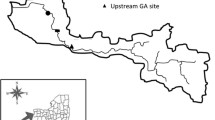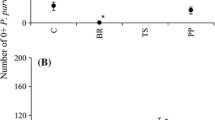Abstract
We used an invaded stream fish community in southern Chile to experimentally test whether the diversity of exotic species affects their competitive impact on a native species. In artificial enclosures an established invasive, rainbow trout, Oncorhynchus mykiss, and a potential invader, Atlantic salmon, Salmo salar, reduced the growth rate of native peladilla, Aplochiton zebra, by the same amount. In enclosures with both exotic salmonids, the growth rates of all three species were the same as in single exotic treatments. While neither species identity nor diversity appeared to affect competitive interactions in this experiment, the impact of salmonid diversity may vary with the type of interspecific interaction and/or the species identity of the exotics. Our experiment links two prominent concepts in invasion biology by testing whether the result of invasional meltdown, an increase in the diversity of exotic species, affects their impact through interspecific competition, the mechanism invoked by the biotic resistance hypothesis.

Similar content being viewed by others
References
Armstrong JD, Kemp PS, Kennedy GJA, Ladle M, Milner NJ (2003) Habitat requirements of Atlantic salmon and brown trout in rivers and streams. Fish Res 62:143–170. doi:10.1016/S0165-7836(02)00160-1
Bisson PA (2006) Assessment of the risk of invasion of national forest streams in the Pacific Northwest by farmed Atlantic salmon. Gen Tech Rep PNW-GTR-697. US Department of Agriculture, Forest Service, Pacific Northwest Station, Portland, OR 28 p
Case TJ (1990) Invasion resistance arises in strongly interacting species-rich model competition communities. Proc Natl Acad Sci USA 87:9610–9614. doi:10.1073/pnas.87.24.9610
Chesson P (2000) Mechanisms of maintenance of species diversity. Annu Rev Ecol Syst 31:343–366. doi:10.1146/annurev.ecolsys.31.1.343
Cussac V, Ortubay S, Iglesias G, Milano D, Lattuca ME, Barriga JP et al (2004) The distribution of South American galaxiid fishes: the role of biological traits and post-glacial history. J Biogeogr 31:103–121
Diamond J, Case TJ (1986) Overview: introductions, extinctions, exterminations, and invasions. In: Diamond J, Case TJ (eds) Community ecology. Harper & Row, New York, pp 65–79
Elton CS (1958) The ecology of invasions by animals and plants. Methuen & Co. Ltd., London
Fridley JD, Stachowicz JJ, Naeem S, Sax DF, Seabloom EW, Smith M et al (2007) The invasion paradox: reconciling pattern and process in species invasions. Ecology 88:3–17. doi:10.1890/0012-9658(2007)88[3:TIPRPA]2.0.CO;2
Futuyma DJ, Slatkin M (eds) (1983) Coevolution. Sinauer, Sunderland
Hartman GF (1965) The role of behavior in the ecology and interaction of underyearling coho salmon (Oncorhynchus kisutch) and steelhead trout (Salmo gairdneri). J Fish Res Bd Can 22:1035–1081
Hearn WE, Kynard BE (1988) Habitat utilization and behavioral interaction of juvenile Atlantic salmon (Salmo salar) and rainbow trout (S. gairdneri) in tributaries of the White River of Vermont. Can J Fish Aquat Sci 43:1988–1998
Kolar CS, Lodge DM (2001) Progress in invasion biology: predicting invaders. Trends Ecol Evol 16:199–204. doi:10.1016/S0169-5347(01)02101-2
Leprieur F, Beauchard O, Blanchet S, Oberdorff T, Brosse S (2008) Fish invasions in the world’s rivers: when natural processes are blurred by human activities. PLoS Biol 6:404–410. doi:10.1371/journal.pbio.0060028
Levine SH (1976) Competitive interactions in ecosystems. Am Nat 110:903–910. doi:10.1086/283116
Losos JB, Leal M, Glor RE, de Queiroz K, Hertz PE, Schettino LR et al (2003) Niche lability in the evolution of a Caribbean lizard community. Nature 424:542–545. doi:10.1038/nature01814
Macarthur R, Levins R (1967) The limiting similarity, convergence, and divergence of coexisting species. Am Nat 101:377–385. doi:10.1086/282505
Mack RN, Simberloff D, Lonsdale WM, Evans H, Clout M, Bazzaz FA (2000) Biotic invasions: causes, epidemiology, global consequences, and control. Ecol Appl 10:689–710. doi:10.1890/1051-0761(2000)010[0689:BICEGC]2.0.CO;2
Marchetti MP, Moyle PB, Levine R (2004) Alien fishes in California watersheds: characteristics of successful and failed invaders. Ecol Appl 14:587–596. doi:10.1890/02-5301
McDowall RM (2006) Crying wolf, crying foul, or crying shame: alien salmonids and a biodiversity crisis in the southern cool-temperate galaxioid fishes? Rev Fish Biol Fish 16:233–422. doi:10.1007/s11160-006-9017-7
McDowall RM, Nakaya K (1988) Morphological divergence in the two species of Aplochiton Jenyns (Salmoniformes: Aplochitonidae): a generalist and a specialist. Copeia 1988:233–236. doi:10.2307/1445940
Moyle PB, Light T (1996) Fish invasions in California: do abiotic factors determine success? Ecology 77:1666–1670. doi:10.2307/2265770
Munoz JL (2006) Synopsis of salmon farming impacts and environmental management in Chile. World Wildlife Fund, Valdivia, Chile, 88 pp
Naylor R, Hindar K, Fleming I et al (2005) Fugitive salmon: assessing the risks of escaped fish from net-pen aquaculture. Bioscience 2005:427–437. doi:10.1641/0006-3568(2005)055[0427:FSATRO]2.0.CO;2
Olden JD, Poff NL, Bestgen KR (2006) Life-history strategies predict fish invasions and extirpations in the Colorado River basin. Ecol Monogr 76:25–40. doi:10.1890/05-0330
Parker IM et al (1999) Impact: toward a framework for understanding the ecological effects of invaders. Biol Invasions 1:3–19. doi:10.1023/A:1010034312781
Pascual M, Macchi P, Urbanski J, Marcos F, Rossi CR, Novara M et al (2002) Evaluating potential effects of exotic freshwater fish from incomplete species presence–absence data. Biol Invasions 4:101–113. doi:10.1023/A:1020513525528
Pascual M, Cussac V, Dyer B, Soto D, Vigliano P, Ortubay S et al (2007) Freshwater fishes of Patagonia in the 21st century after a hundred years of human settlement, species introductions and environmental change. Aquat Ecosyst Health Manag 10:212–227. doi:10.1080/14634980701351361
Riccardi A (2001) Facilitative interactions among aquatic invaders: is an “invasional meltdown” occurring in the Great Lakes? Can J Fish Aquat Sci 58:2513–2525. doi:10.1139/cjfas-58-12-2513
Riccardi A, Atkinson SK (2004) Distinctiveness magnifies the impact of biological invaders in aquatic ecosystems. Ecol Lett 7:781–784. doi:10.1111/j.1461-0248.2004.00642.x
Roughgarden J (1983) Competition and theory in community ecology. Am Nat 122:583–601. doi:10.1086/284160
Shea K, Chesson P (2002) Community ecology as a framework for biological invasions. Trends Ecol Evol 17:170–176. doi:10.1016/S0169-5347(02)02495-3
Simberloff D (2006) Invasional meltdown 6 years later: important phenomenon, unfortunate metaphor, or both? Ecol Lett 9:912–919. doi:10.1111/j.1461-0248.2006.00939.x
Simberloff D, Von Holle B (1999) Positive interactions of nonindigenous species: invasional meltdown? Biol Invasions 1:21–32. doi:10.1023/A:1010086329619
Soto D, Arismendi I, Gonzalez J, Sanzana J, Jara F, Jara C et al (2006) Southern Chile, trout and salmon country: invasion patterns and threats for native species. Rev Chil Hist Nat 79:97–117
Stone L, Roberts A (1991) Conditions for a species to gain advantage from the presence of competitors. Ecology 72:1964–1972. doi:10.2307/1941551
Thorstad EB, Fleming IA, McGinnity P, Soto D, Wennevik V, Whoriskey F (2008) Incidence and impacts of escaped farmed Atlantic salmon Salmo salar in nature. Salmon Aquaculture Dialogues, 113 pp
Volpe JP, Taylor EB, Rimmer DW, Glickman BW (2000) Evidence of natural reproduction of aquaculture-escaped Atlantic salmon in a coastal British Columbia river. Conserv Biol 14:899–903. doi:10.1046/j.1523-1739.2000.99194.x
Volpe JP, Anholt BR, Glickman BW (2001) Competition among juvenile Atlantic salmon (Salmo salar) and steelhead (Oncorhynchus mykiss): relevance to invasion potential in British Columbia. Can J Fish Aquat Sci 58:197–207. doi:10.1139/cjfas-58-1-197
Webb CO, Ackerly DD, McPeek MA, Donoghue MJ (2002) Phylogenies and community ecology. Annu Rev Ecol Syst 33:475–505. doi:10.1146/annurev.ecolsys.33.010802.150448
Young KA (2003) Evolution of fighting behavior under asymmetric competition: an experimental test with juvenile salmonids. Behav Ecol 14:127–134. doi:10.1093/beheco/14.1.127
Young KA (2004) Asymmetric competition, habitat selection and niche overlap in juvenile salmonids. Ecology 85:134–149. doi:10.1890/02-0402
Zimmerman JKH, Vondracek B (2006) Effects of stream enclosures on drifting invertebrates and fish growth. J N Am Benthol Soc 25:453–464. doi:10.1899/0887-3593(2006)25[453:EOSEOD]2.0.CO;2
Acknowledgements
We thank Abraham Guevara for allowing us to conduct this experiment on his land and the neighbors of Guardanamo for their assistance and understanding. We thank Sonia Consuegra, Jason Dunham and Ian Fleming for discussions and comments. This work was funded by the Department for Environment Food and Rural Affairs (DEFRA, UK) Darwin Initiative Grant # 162-15-020 with support from the Universidad de Los Lagos.
Author information
Authors and Affiliations
Corresponding author
Rights and permissions
About this article
Cite this article
Young, K.A., Stephenson, J., Terreau, A. et al. The diversity of juvenile salmonids does not affect their competitive impact on a native galaxiid. Biol Invasions 11, 1955–1961 (2009). https://doi.org/10.1007/s10530-008-9372-5
Received:
Accepted:
Published:
Issue Date:
DOI: https://doi.org/10.1007/s10530-008-9372-5




